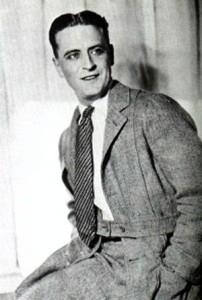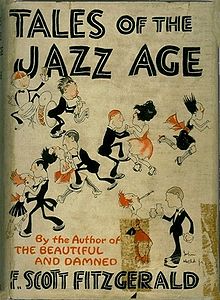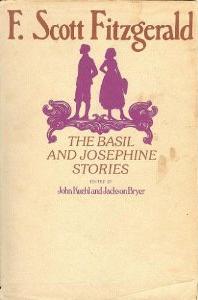
photo by Chris Weeks
by Jade Broughton
F. Scott Fitzgerald (1896-1940) is usually remembered as a novelist, and often as the ‘Jazz Age Laureate’. What is seldom addressed is that in his own lifetime, Fitzgerald was better known as a short story writer. Each of his four novels was followed with a collection of short stories, and he wrote a staggering 178 stories over the course of his two decade career. The vast majority of these stories were published in popular magazines, and during the 1920s he was specifically associated with the Saturday Evening Post. His struggles with alcoholism and turbulent family life stunted his productivity from around the publication of The Great Gatsby (1925) onwards, but he still managed to produce short stories to sell with impressive consistency to the ‘slick’ magazines. He died in 1940 of a heart attack, leaving an unfinished but brilliant fragment of a Hollywood novel, The Love of the Last Tycoon, and a literary legacy which has influenced writers as diverse as J. D. Salinger, Brett Eaton Ellis, and Haruki Murakami.
 The epithet ‘chronicler of the Jazz Age’ is reductive. Whilst it is true that Fitzgerald was a social realist (focusing on particular strata of society), his relationship with the Jazz Age was more reciprocal. Not merely a recorder, Fitzgerald was also an influence on popular culture. He exerted this influence by being a mainstay of the popular magazines, especially the Post, which was read in hundreds of thousands of middle class homes. Fitzgerald’s stories of flappers and playboys were read in conjunction with advertisements for consumer goods, non-fiction accounts of news and politics, as well as cartoons and human interest articles. But Fitzgerald’s relationship with these magazines – the ‘slicks’ – was complex. Reliant on them for income which allowed him to write novels, Fitzgerald resented having to do such ‘hack work’ and was aware that he was at risk of becoming more well-known as a Post author than as a novelist in his own right. Yet he couldn’t support himself and his family on novel royalties alone. In 1929, Fitzgerald earned only $30.64 from royalties on his six books; the Post could afford to pay him his career-high of $4,000 a story.
The epithet ‘chronicler of the Jazz Age’ is reductive. Whilst it is true that Fitzgerald was a social realist (focusing on particular strata of society), his relationship with the Jazz Age was more reciprocal. Not merely a recorder, Fitzgerald was also an influence on popular culture. He exerted this influence by being a mainstay of the popular magazines, especially the Post, which was read in hundreds of thousands of middle class homes. Fitzgerald’s stories of flappers and playboys were read in conjunction with advertisements for consumer goods, non-fiction accounts of news and politics, as well as cartoons and human interest articles. But Fitzgerald’s relationship with these magazines – the ‘slicks’ – was complex. Reliant on them for income which allowed him to write novels, Fitzgerald resented having to do such ‘hack work’ and was aware that he was at risk of becoming more well-known as a Post author than as a novelist in his own right. Yet he couldn’t support himself and his family on novel royalties alone. In 1929, Fitzgerald earned only $30.64 from royalties on his six books; the Post could afford to pay him his career-high of $4,000 a story.
Despite his reliance on them, he was profoundly ambivalent about his relationship with magazines such as the Post, struggling to reconcile his need for cash with his need for literary validation. Famously, in 1929 Fitzgerald wrote to Hemingway complaining that ‘the Post now pays the old whore $4,000 a screw. But now its [sic.] because she’s mastered the 40 positions – in her youth one was enough’. Yet he was proud of his work, and often took lines from his stories and recycled them in his novels: a practice he called ‘stripping’. If a story had been borrowed from extensively, he wouldn’t include it in one of his collections. But his fears about being known as a Post author would subside by the mid-1930s: he wrote to his wife Zelda that ‘I lost the knack of writing the particular kind of stories they wanted…you no longer have a chance of selling a story with an unhappy ending’. More lucrative than story-writing, but more disruptive to his novel-writing, Fitzgerald eventually turned to Hollywood for the income he needed to sustain himself and his family, to repay his debts, and to give him a shot at completing his final novel, The Last Tycoon. He succeeded in two out of the three ventures.
 A renewal of interest in the stories began in the 1980s and 1990s, and although few scholars would argue that all Fitzgerald stories are of the same literary quality as the novels, stories previously dismissed as ‘hack-work’ are now garnering critical appreciation. Though writing for a different audience than that which he hoped would read his novels, in the magazine fiction we find an enormous variety of genre explorations. Fitzgerald wrote traditional romances, like ‘Head and Shoulders’ (1920) which employed the twist ending The Post audience enjoyed, in which a reserved academic and a vivacious chorus girl, ‘a blonde by natural pigment’ whose ‘speaking voice was like byplay on a harp’, switch roles through the unlikely relationship they embark upon. He also placed subversively un-romantic romances in the same magazine, such as ‘The Last of the Belles’ (1929), in which the protagonist, Andy, not only fails to get the girl, but also ends the story scrabbling about ‘in the knee-deep underbrush, looking for [his] youth in a clapboard or a strip of roofing or a rusty tomato can’. He wrote stories whose length could arguably render them novellas (‘May Day’ [1920] and ‘The Rich Boy’ [1926]). He tried his hand at ghost stories (‘One Trip Abroad’ [1930]), detective stories (‘A Short Trip Home’ [1927]), fantasy stories (‘The Diamond as Big as the Ritz’ [1922]), fables (‘The Curious Case of Benjamin Button’ [1922]), a story that could be classed as a non-fiction essay (‘Afternoon of an Author’ [1936]), and fragmentary sketches (‘The Lost Decade’ [1939]). To remember Fitzgerald only for Gatsby is to miss out on an incredibly rich bank of short fiction.
A renewal of interest in the stories began in the 1980s and 1990s, and although few scholars would argue that all Fitzgerald stories are of the same literary quality as the novels, stories previously dismissed as ‘hack-work’ are now garnering critical appreciation. Though writing for a different audience than that which he hoped would read his novels, in the magazine fiction we find an enormous variety of genre explorations. Fitzgerald wrote traditional romances, like ‘Head and Shoulders’ (1920) which employed the twist ending The Post audience enjoyed, in which a reserved academic and a vivacious chorus girl, ‘a blonde by natural pigment’ whose ‘speaking voice was like byplay on a harp’, switch roles through the unlikely relationship they embark upon. He also placed subversively un-romantic romances in the same magazine, such as ‘The Last of the Belles’ (1929), in which the protagonist, Andy, not only fails to get the girl, but also ends the story scrabbling about ‘in the knee-deep underbrush, looking for [his] youth in a clapboard or a strip of roofing or a rusty tomato can’. He wrote stories whose length could arguably render them novellas (‘May Day’ [1920] and ‘The Rich Boy’ [1926]). He tried his hand at ghost stories (‘One Trip Abroad’ [1930]), detective stories (‘A Short Trip Home’ [1927]), fantasy stories (‘The Diamond as Big as the Ritz’ [1922]), fables (‘The Curious Case of Benjamin Button’ [1922]), a story that could be classed as a non-fiction essay (‘Afternoon of an Author’ [1936]), and fragmentary sketches (‘The Lost Decade’ [1939]). To remember Fitzgerald only for Gatsby is to miss out on an incredibly rich bank of short fiction.
Short story writing for Fitzgerald served many different purposes. Not in the habit of recording ideas in notebooks until the last decade of his life, Fitzgerald looked to the stories to help with his novel-writing. He habitually ‘workshopped’ a character or theme that he planned to use in a novel in a group of stories written at the same time as the novel was gestating. Rosemary Hoyt, the actress in Tender is the Night (1934), has a previous incarnation as Jenny Prince in ‘Jacob’s Ladder’ (1927). ‘Absolution’ (1924) explores the childhood of Rudolph Miller, an exploration of Jay Gatsby’s childhood. ‘One Trip Abroad’ (1930) explores the destructive effect on Nelson and Nicole Kelly as they drift around Europe. Over the course of the next four years, Nicole Kelly grows into Nicole Diver of Tender is the Night.
 Fitzgerald also explored the possibilities of the short story cycle, writing several series of stories that dealt with the same casts of characters. ‘The Basil stories’ (1928-9) were set in the years of Fitzgerald’s adolescence in St. Paul, Minnesota. ‘The Josephine stories’ (1930-1) explored Basil’s female counterpart, based in part on Fitzgerald’s first love, Ginevra King. Fitzgerald planned to write a story in which Basil and Josephine would meet, and fall in love, but this never materialized. Fitzgerald toyed with the idea of publishing the ‘Basil’ and ‘Josephine’ stories together in a collection, but decided against it on the basis of what he viewed as inferior quality. Fitzgerald also began a series of stories based on the adolescence of his daughter, Scottie, known as ‘the Gwen stories’, (1936) but only two were written. He also wrote three interconnected stories dealing with a Georgia town, ‘The Tarleton Trilogy’, which was actually based on Zelda’s youth in Montgomery, Alabama. This experimentation with the short story cycle was influenced by Fitzgerald’s respect for his peers’ work in this arena. Sherwood Anderson’s Winesburg, Ohio and Ernest Hemingway’s In Our Time impressed him deeply, and his ongoing fascination with James Joyce led Fitzgerald to excitedly offer to kill himself, as a demonstration of his admiration when the pair finally met.
Fitzgerald also explored the possibilities of the short story cycle, writing several series of stories that dealt with the same casts of characters. ‘The Basil stories’ (1928-9) were set in the years of Fitzgerald’s adolescence in St. Paul, Minnesota. ‘The Josephine stories’ (1930-1) explored Basil’s female counterpart, based in part on Fitzgerald’s first love, Ginevra King. Fitzgerald planned to write a story in which Basil and Josephine would meet, and fall in love, but this never materialized. Fitzgerald toyed with the idea of publishing the ‘Basil’ and ‘Josephine’ stories together in a collection, but decided against it on the basis of what he viewed as inferior quality. Fitzgerald also began a series of stories based on the adolescence of his daughter, Scottie, known as ‘the Gwen stories’, (1936) but only two were written. He also wrote three interconnected stories dealing with a Georgia town, ‘The Tarleton Trilogy’, which was actually based on Zelda’s youth in Montgomery, Alabama. This experimentation with the short story cycle was influenced by Fitzgerald’s respect for his peers’ work in this arena. Sherwood Anderson’s Winesburg, Ohio and Ernest Hemingway’s In Our Time impressed him deeply, and his ongoing fascination with James Joyce led Fitzgerald to excitedly offer to kill himself, as a demonstration of his admiration when the pair finally met.
Fitzgerald’s short stories are generally held in lower critical esteem than his novels for two reasons. Firstly, because of Fitzgerald’s own ambivalence: he was often dismissive of his short fiction, resenting it for intruding on his novel-writing, but at other times revelling in how skilled he was at producing work for the ‘slicks’. He certainly took it hard when he failed to command top dollar for his work. The second reason is the inconsistency of the stories. Leading Fitzgerald scholar Jackson R. Bryer diplomatically describes the stories as ‘often not totally successful’, some of the twist endings can be construed as contrived; some characters can be interpreted as two-dimensional; and some coincidences occur too frequently to be believable. Yet sometimes these accusations can be levied at what remains a great story. In ‘The Swimmers’ (1929), the protagonist meets an American girl in France, and then bumps into her again not once, but twice: once in America and once on a transatlantic crossing. Yet the story is successful: Fitzgerald’s agent described it as ‘the ablest and most thoughtful story [Fitzgerald had] ever done’. In reading his stories, questions arise about what it is that we value in literature. Why does sentimentality designate ‘pot-boiler’ in a magazine story but not in The Great Gatsby? What part does self-censorship play in writing for a magazine with such editorial expectations? Can a story, like ‘The Swimmers’, display a mastery of commercial story plot twists at the same time as being a literarily ‘successful’ story? Fitzgerald found writing the stories just as difficult as his novel-writing; stories simply provided more prompt paycheques. As he explained in his Notebooks, the stories cost him dearly: “I have asked a lot of my emotions – one hundred and twenty stories. The price was high, right up with Kipling, because there was one little drop of something not blood, not a tear, not my seed, but me more intimately than these, in every story, it was the extra I had. Now it is gone and I am just like you now”.


Thank you for this interesting article. Fitzgerald is one of my ‘touchstone’ writers; I reread his work regularly – or as much as I can bear because of its intense sadness – especially somehow in the short stories. I recently read ‘A Moveable Feast’ by Ernest Hemingway, his memoir of Paris, and there is a tragi-comic account of going on a road trip in France with Fitzgerald. Sometimes it is better not to know a writer’s life!